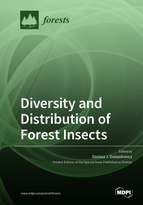Diversity and Distribution of Forest Insects
A special issue of Forests (ISSN 1999-4907). This special issue belongs to the section "Forest Biodiversity".
Deadline for manuscript submissions: closed (25 March 2022) | Viewed by 24916
Special Issue Editor
Interests: nature conservation, insect ecology, zoogeography; forest bioindicators
Special Issues, Collections and Topics in MDPI journals
Special Issue Information
Dear Colleagues,
Forests are the richest and most complex ecosystems in the world. Due to the abundance of species and their intricate relationships, huge problems are faced when investigating and analyzing them, despite the fact that increasingly sophisticated research tools are currently available, such as electron microscopy or molecular techniques. This is also true in the case of the most numerous group of animals in the world, i.e., insects inhabiting the forest environment. Interdisciplinary studies conducted by international teams are developing dynamically, with new species being described every year and with new links in ecological dependencies being identified, indicating a key role of insects.
We are currently living in times of dramatic environmental changes triggered by human activity. The effects of climate change are evident and lead to changes in forests. Growing numbers of insect species are being threatened, and it is our responsibility to protect them. On the other hand, we are witnessing the increased activity of many species, which causes considerable economic losses when feeding on leaves or damaging timber—a serious problem faced by foresters.
This Special Issue of our journal aims to provide a platform for scientific discussions on an array of research problems, such as geographic or historic diversity of forest insects, their variability, habitat preferences, as well as their monitoring or use as bioindicators of environmental changes. We are convinced that this Special Issue will not only be a source of inspiration for further research but will also contribute to reaching a reasonable compromise between the necessary protection of forests and the need for economic benefits. It is our belief that entomological studies will be of considerable value in these efforts.
Prof. Dr. Dariusz J. Gwiazdowicz
Guest Editor
Manuscript Submission Information
Manuscripts should be submitted online at www.mdpi.com by registering and logging in to this website. Once you are registered, click here to go to the submission form. Manuscripts can be submitted until the deadline. All submissions that pass pre-check are peer-reviewed. Accepted papers will be published continuously in the journal (as soon as accepted) and will be listed together on the special issue website. Research articles, review articles as well as short communications are invited. For planned papers, a title and short abstract (about 100 words) can be sent to the Editorial Office for announcement on this website.
Submitted manuscripts should not have been published previously, nor be under consideration for publication elsewhere (except conference proceedings papers). All manuscripts are thoroughly refereed through a single-blind peer-review process. A guide for authors and other relevant information for submission of manuscripts is available on the Instructions for Authors page. Forests is an international peer-reviewed open access monthly journal published by MDPI.
Please visit the Instructions for Authors page before submitting a manuscript. The Article Processing Charge (APC) for publication in this open access journal is 2600 CHF (Swiss Francs). Submitted papers should be well formatted and use good English. Authors may use MDPI's English editing service prior to publication or during author revisions.
Keywords
- insect diversity
- zoogeography
- insect conservation
- forest entomology
- insect pests
- monitoring
- bioindicators






